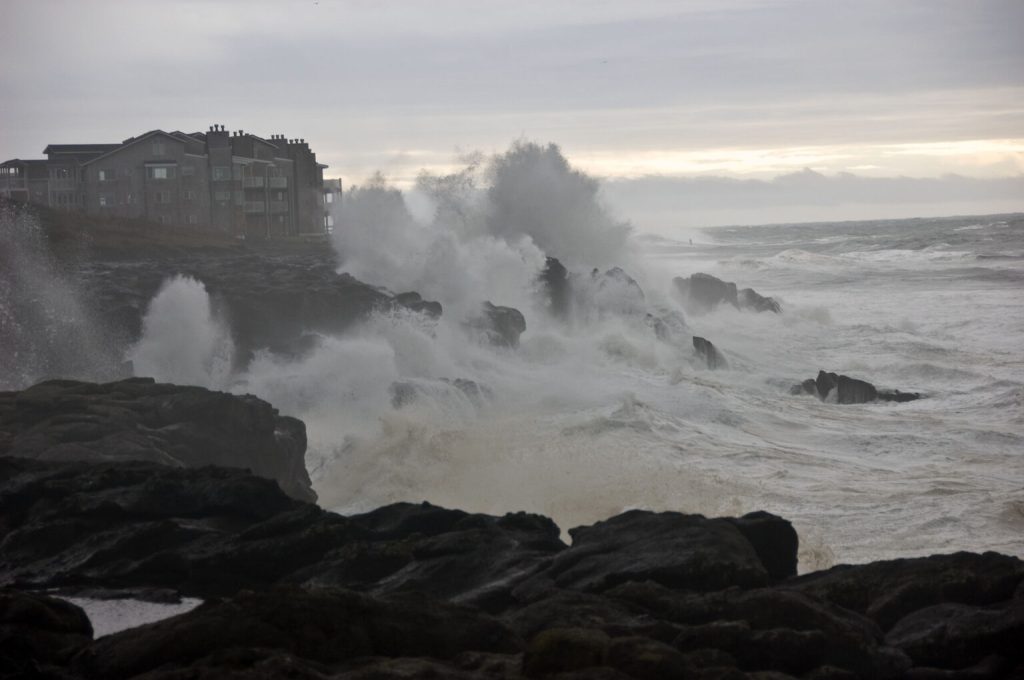In the wake of tsunami warning, Oregon lawmaker calls for better state disaster preparedness
Published 6:21 am Wednesday, August 6, 2025

- Waves pound a beach and structure between Depoe Bay and Boiler Bay on the Oregon Coast. (Erica Harris/Oregon State University)
State Rep. Paul Evans, D-Monmouth, will propose a $300 million package to get more disaster training facilities statewide and to create a new response office under the governor
Oregon state Rep. Paul Evans, D-Monmouth, has been introducing legislation to modernize the state’s emergency preparedness and response processes for years. He called the state’s tsunami warnings last week to residents on the Oregon Coast — raised due to strong currents and unpredictable waves as a result of a massive earthquake off the coast of Russia — “a good warmup.” No one was injured, and the Oregon Department of Emergency Management called the warning off within 24 hours.
But, Evans said, it also highlighted the ways in which Oregon is behind other states in providing quality information quickly to everyone in a potential disaster impact zone, and when it comes to training volunteers to respond to them.
“We just have a lot more to do because ultimately, even as we’re working to improve, federal capacity is being cut,” Evans said.
Trending
President Donald Trump in June said the Federal Emergency Management Agency could be eliminated by December.
“We’re going to be on our own for a longer period of time, and we need to be prepared for that,” Evans said.
Oregonians on the coast who signed up for the state’s emergency notification system, OR-Alert, got a text to stay away from beaches, harbors and marinas. City and county police, firefighters and other officials warned people on the ground in coastal communities to stay inland.
But the state’s text alerts only went to people who subscribed to them, rather than anyone with a cell phone within the potentially impacted areas. And there weren’t any texts following the initial warning that provided more information about a timeline for potential impact, how high waves could be and what to do if waves were carrying large objects onto shores as they crashed. Tsunamis can occur more than 20 hours after initial waves, according to the National Oceanic and Atmospheric Administration.
The state also lacks the volunteers and emergency responders to take care of multiple disasters at once, Evans said.
“Had we had a major tsunami, we would have been stretched beyond our capacity, because we’re currently also fighting wildfires, and the number of responders has gone down over the years,” he said.
Trending
In response, he’ll bring a three-pronged, $300 million disaster preparedness package to the state Legislature in early 2026.
First, it would create six to seven new emergency responder training facilities over the next decade, to train volunteers to respond to different kinds of disasters across the state, such as wildfires, ice storms, floods and, of course, tsunamis.
Second, it would create a Disaster Recovery Authority housed in the governor’s office to direct the state’s response and coordinate state agencies after any emergency both in the short and long term, including hiring more people and coordinating federal and private aid. It’s a similar function given to Utah’s lieutenant governor, who leads an Emergency Management Administration Council.
The Emergency Management Administration Council was created to provide advice and coordination for state and local government agencies on government emergency prevention, mitigation, preparedness, response, and recovery actions and activities.
The third prong of the package would create a program that grants state funding to local emergency authorities across the state to help them pay for specific needs based on specific types of disasters they’re most likely to face.
More training
There is no standardized, multi-disciplinary disaster training ground for first responders and volunteers in Oregon, Evans said, just academies focused on a single discipline at the local level. In some states, such as Florida, every volunteer firefighter is trained and graduates from a state-run program.
Evans, a 20-year veteran of the U.S. Air Force and Oregon Air National Guard and a former volunteer firefighter, said the state is having trouble maintaining its current forces of volunteer firefighters and emergency responders in part because trainings are hard to find and schedule when they’re offered piecemeal at local agencies. He’d like to see monthly trainings available at multiple facilities statewide across disciplines so more people can participate.
When the Department of Public Safety Standards and Training was established in 2001, it was supposed to be a hub for smaller facilities established across the state. But those smaller training sites never got built, Evans said.
The package he’ll propose is an amalgamation of several bills that Evans has tried to pass before. In the most recent Legislative session, he sponsored House Bill 2858, to create the statewide preparedness training facilities, and House Bill 2770, which would have created the Disaster Recovery Authority in the governor’s office. Both bills failed to advance out of legislative committees.
“We’re going to try to approach the 2026 session as if that’s the last stand,” Evans said. “If anybody wants anything out of me, we’re going to be working on this.”
He said the state has made progress modernizing in small ways over the last several years. In 2017, the Legislature created an equipment sharing and grant program called SPIRE, where the state buys rescue boats, all-terrain vehicles and other emergency equipment that local agencies can use, but that the state retains ownership of and can retrieve when needed.
In 2022, the state made the Oregon Department of Emergency Management a stand alone agency with its own funding separate from the State Police and the Military Department, where it used to be housed. In 2023, the Oregon Department of the State Fire Marshal also became a standalone agency, whereas before it had played a supporting role in the Oregon State Police.
The Legislature recently provided the emergency management department enough money so that it could run a 24-hour operation center, which will begin operating in July, Evans said. He hopes this improves the quality and speed of notifications and updates people statewide receive in a disaster. Evans called all of this “a first step.”







